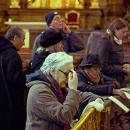The Importance of Gestures in Worship

The act of crossing oneself to some Protestants, not to mention some Lutherans, seems disturbingly Catholic and out of place in worship. Yet, it is so indicative of our theology (cross-centered) and has unfortunately been lost from much of the general piety of our church. So too with many of the traditional gestures of worship. The other day while worshiping at a local pastor's conference I noticed that the pastor next to me was responding to the divine service with the same gestures I am accustomed to using: crossing, bowing, etc. It felt refreshing. But the question a Lutheran today may still ask: "Are such actions not mere empty ritualism?" "Isn't it more important to know what is in the heart?"
Naturally anything done in rote fashion for the mere sake of doing it, without an understanding of its purpose and place in worship, can easily break down into empty ritualism. On the other hand, intentional gestures, understood and appropriately used, can also be an invaluable aid to worship. We practice this reality every time we fold our hands to pray. Certainly such an action is not required and is not commanded in scripture. Still, we do this, sometimes out of blind habit, yet aware at times also that it disciplines our body to respond to the worship of addressing our heavenly Father (we control our hands as to better concentrate and focus.) So too with other gestures of worship. Bowing at the name of the persons of the Trinity in the Creed disciplines my body in such a way that my mind is reminded of the humility and reverence required in the presence of our holy God. Likewise with kneeling at the altar to receive the body and blood of Christ at the Blessed Supper. Or, again, when one crosses oneself at the mention of the Trinity, or at the end of the creed, or at the conclusion of the absolution, where it can be a way of acknowledging the reception of the gift there given.
Worship is an act that involves both body and mind, and gestures in worship help to coordinate this reality as well as discipline the heart in realization of the reality one stands within: the holiness of God. One wonders how the reintroduction of these gestures of worship might change the unfortunate casualness that has marred so much of worship today.



Comments